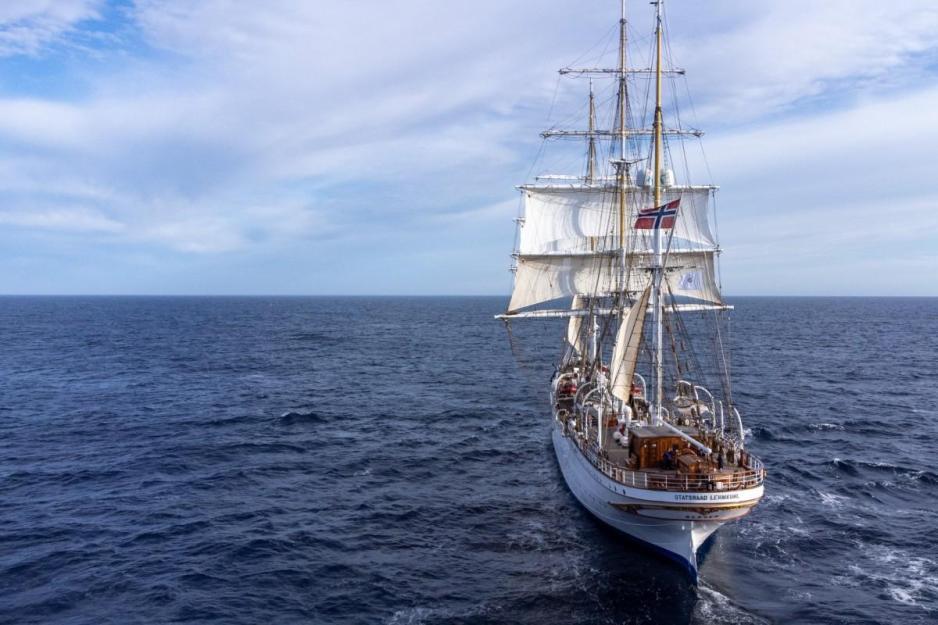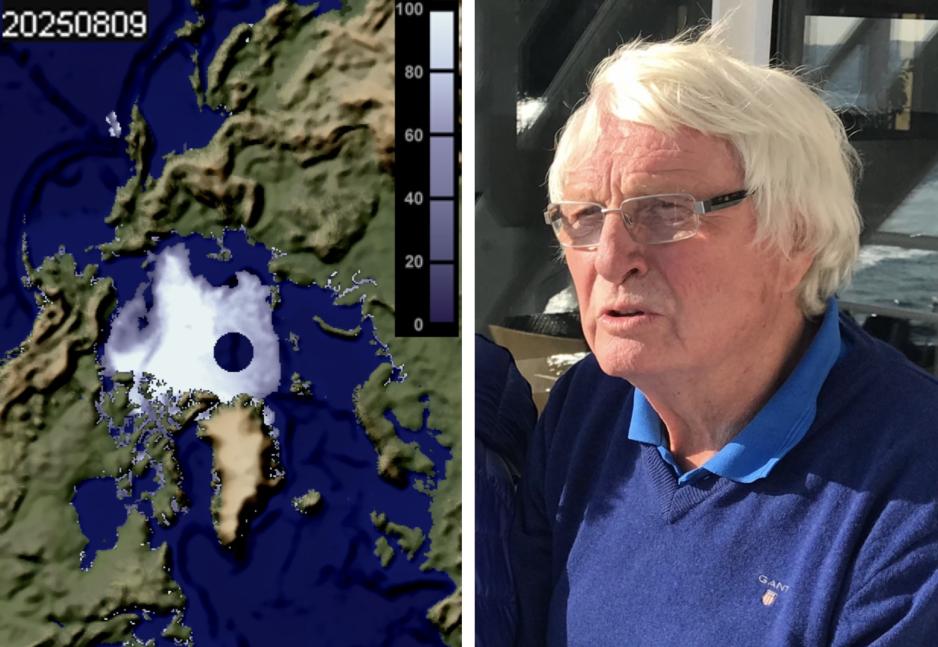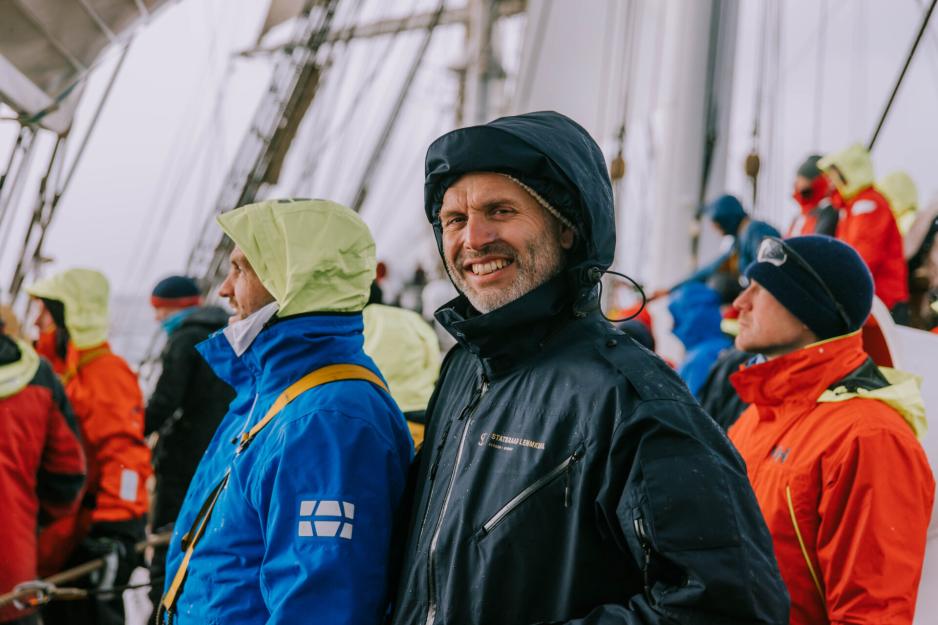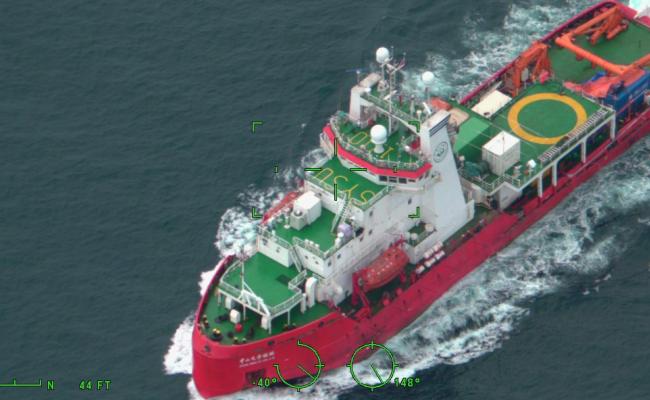Statsraad Lehmkuhl’s Voyage Was Poorly Planned, Says Researcher

On August 5th, the tall ship Statsraad Lehmkuhl departed from Nuuk, Greenland, and set course for the Northwest Passage. Here it is the Davis Strait, heading for the first stop at Pond Indlet on the Canadian Baffin Island before ice conditions forced it to change course. (Photo: André Marton Pedersen/Statsraad Lehmkuhl)
The Norwegian tall ship Statsraad Lehmkuhl recently had to cancel a voyage through the Northwest Passage due to ice conditions. The voyage should have taken place in September, when sea ice extent is at its lowest, states a researcher. The expedition leader responds to the criticism.
The ship, chartered by UiT The Arctic University of Norway, for an extensive education and research voyage, then altered its course southward.
"Although the ice charts for large parts of the route have looked promising, recent data show that the upcoming ice conditions could possibly exceed what the sailing ship is certified for. This particularly applies to the Western part of the Canadian Arctic, in which the ice melting has started later than usual," informed the Statsraad Lehmkuhl Foundation.
The experienced Norwegian polar researcher Ola M. Johannessen, Professor of Oceanography, is critical of the choice to sail the passage in early August.
"It does not surprise me that Statsraad Lehmkuhl had to cancel its voyage through the Northwest Passage. There is usually the least sea ice in the Arctic in mid-September, but with variations. For example, the Northeast Passage is now ice-free, but the Northwest Passage is not," says Johannessen to High North News, referring to an ice chart of the latter sea route.

To the left: Ice chart over the Northwest Passage for August 9th. (Source: the Nansen Center). To the right: Ola M. Johannessen, Professor of Oceanography and former director of the Nansen Center in Bergen, Norway. (Photo: Private)
"In other words, there is still a lot of ice in the Northwest Passage, but there will be less ice toward the middle of next month, and the passage could possibly become completely ice-free. Therefore, I don't understand that the planners of the Statsraad Lehmkuhl voyage set it to the beginning of August and not September," continues Johannessen.
"Something has failed in the planning stage, despite there being many ice researchers at UiT and the Norwegian Polar Institute in Tromsø. This is a loss of prestige for the ice research environment in Tromsø, for the entire project, and also for Norway," he believes.
Denies failure
Haakon Vatle, expedition leader and CEO of the Statsraad Lehmkuhl Foundation, responds to the criticism:
"We can ensure Johannessen that there has been no failure in planning, and we are naturally familiar with the information he brings up," writes Vatle in an e-mail to HNN.
"We are aware that it is early in the season, but the development over the past ten years shows that the ship could have carried out the planned voyage at the given time, except for two years where we would have had to wait a week for the right conditions."

Haakon Vatle, CEO of the Statsraad Lehmkuhl Foundation and leader of the One Ocean Expedition, of which the planned voyage through the Northwest Passage was to be a part of. (Photo: Hanna Thevik)
Furthermore, he points to calculations of RIO values (Risk Index Outcome) using data on ice conditions in the years 2014-2024, all within the framework of the Polar Operational Limit Assessment Risk Indexing System (POLARIS).
This system is approved by the International Maritime Organisation (IMO) as a methodology for assessing a ship's performance and limitations when operating in icy waters. The assessment is based on information on actual ice conditions and the ship's ice reinforcement.
"In other words, using RIO, we find that Statsraad Lehmkuhl could have sailed through the Northwest Passage in August in eight of the last ten years," Vatle states.
We have spent over two and a half years planning this voyage.
Long process with a lot of input
"The original sailing schedule also included a very low average speed (about 3,5 knots), possibilities for alternative sailing routes, and most importantly: being able to wait for a longer time for better ice conditions when needed," Vatle elaborates.
He underlines that the foundation has engaged skilled people and spent a significant amount of time on the planning process.
"We have spent over two and a half years planning this exact voyage through the Northwest Passage, closely cooperating with UiT and a highly qualified safety committee, which includes our insurance agents," states Vatle and continues:
"In addition to all the historical data we have utilized in our planning, the most important resource has been our Canadian ice pilot, Stéphan Guy. With over 40 years of practical experience from the Arctic and a double-digit number of passages through the Northwest Passage, he has been a key person in the planning and the intended voyage."
We are not the first ship to have had to turn around, and we will not be the last.
Unpredictable either way
"Guy has been clear that the plan was possible to conduct at the given time, but at the same time, we have all been well aware of how there are no guarantees when it comes to the Northwest Passage," notes Vatle.
This uncertainty regarding ice conditions cannot be escaped even if the voyage had been planned for September, he points out.
"You can always discuss afterwards whether you could have had better ice conditions by planning the voyage at a later time, but this is not a guarantee either. Conditions in the Arctic are unpredictable; we are not the first ship to have had to turn around, and we will not be the last. It is, of course, disappointing, but it is a risk we have been aware of."
"Good and trust-inspiring dialogue"

On its part, UiT does not seem to have any objections to the planning of the voyage.
"We have had a good and trust-inspiring dialogue with the Statsraad Lehmkuhl Foundation, also when they decided to set a new course while in Arctic waters due to security concerns," writes Jørgen Berge, Pro-Rector for Research and Development at UiT, to HNN.
Last Monday, UiT decided that the 78 students and researchers aboard the tall ship would disembark at St. John's on Canada's eastern coast.
There, the students will complete the course Arctic Future Pathfinders in cooperation with Memorial University of Newfoundland.
A plan is currently being drawn up for the new group of students who were supposed to have come aboard at Cambridge Bay on August 29th for the onward voyage to Whittier, Alaska.

Participants in the course Arctic Future Pathfinders during sailing on Statsraad Lehmkuhl. The course is linked to the Norwegian research project Arctic Ocean 2050 and the upcoming International Polar Year 2032-33. The goal is to train students and young academics to become polar researchers. (Photo: Karine Nigar Aarskog/UiT)
The financial aspect
The total budget for the aforementioned academic course, which forms the basis for UiT's chartering of Statsraad Lehmkuhl, is NOK 30 million.
This includes 10 million for the rental of the tall ship and salaries for UiT employees who participate in the planning and implementation of the voyage, according to the pro-rector.
"UiT expects a total final cost of approximately NOK eight million when we deduct financial contributions from other participating educational institutions and collaborating organizations, as well as indirect costs," writes Berge and continues:
"We are now working on an alternative plan for the two stages of the course. We have to come back to how this will affect the budget."




